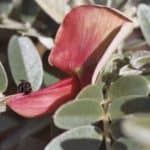As part of the ongoing monitoring to measure what the effects will be of predator removal on the ecosystem at Kaena Point Natural Area Reserve, Pacific Rim Conservation in collaboration with the Hawaii Department of

Land and Natural Resources and the US Fish and Wildlife Service Coastal Program, conducted an intensive three day long biological survey in March as part of the Kaena Point Ecosystem Restoration Project. Insects were collected and identified from points throughout the reserve to document whether the removal of rats will cause changes in proportions of native insects, such as yellow faced bees, and non-native insects, such as ants. Small soil samples were also collected to determine whether increases in seabird numbers will impact the nutrients in the soils and the marine intertidal habitat was surveyed to document whether rats are having an impact on marine invertebrates, such as opihi. Previous surveys have already been done on the plants and birds at Kaena to look at similar questions. Overall, the removal of non-native predators, such as rats, mongoose and cats are expected to have a large benefit to the native species found at Kaena Point.
